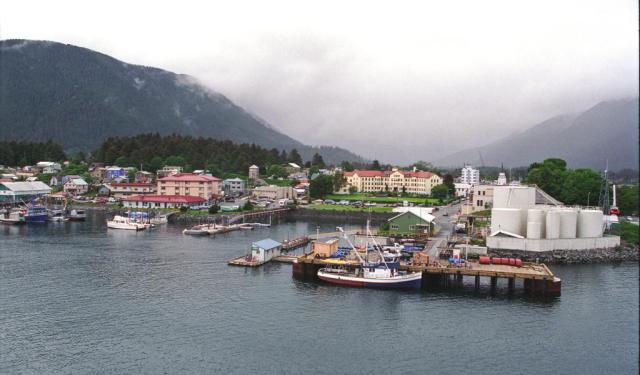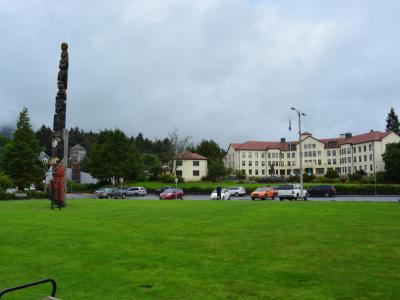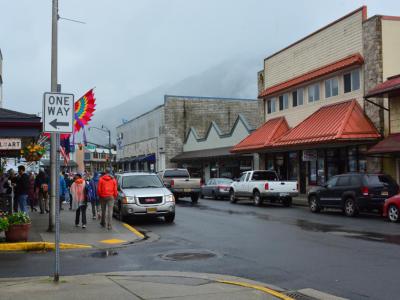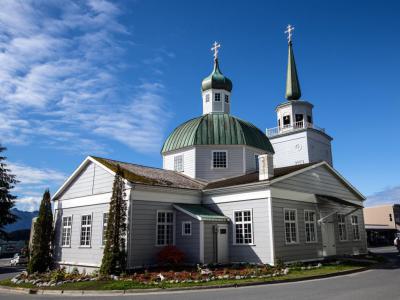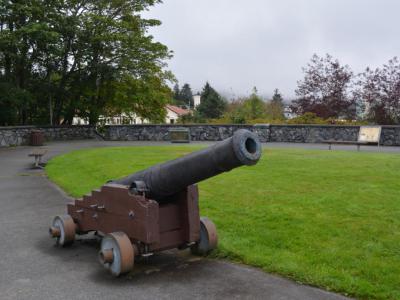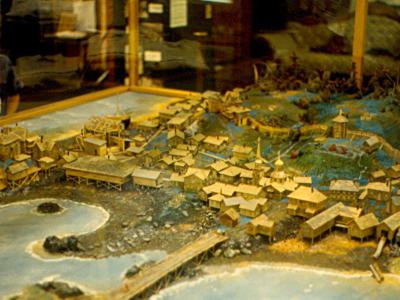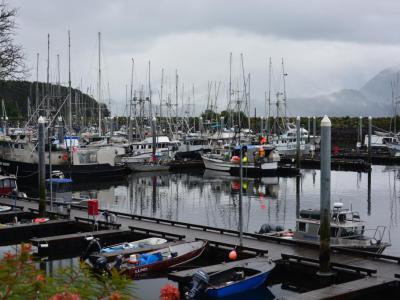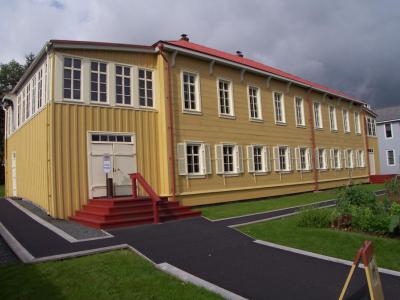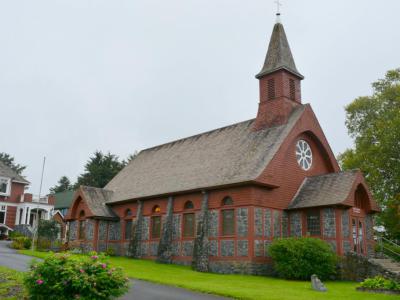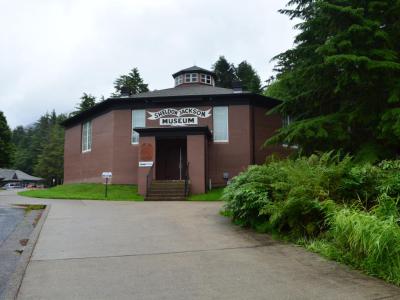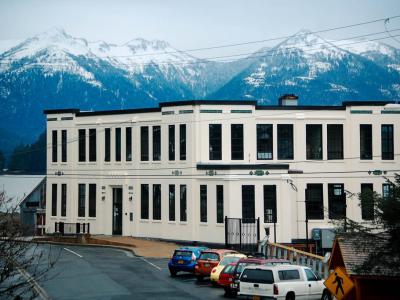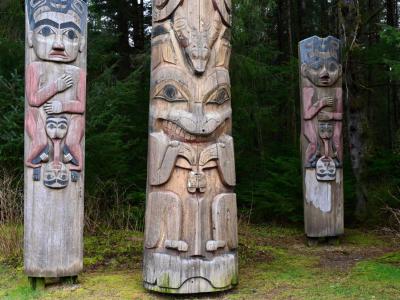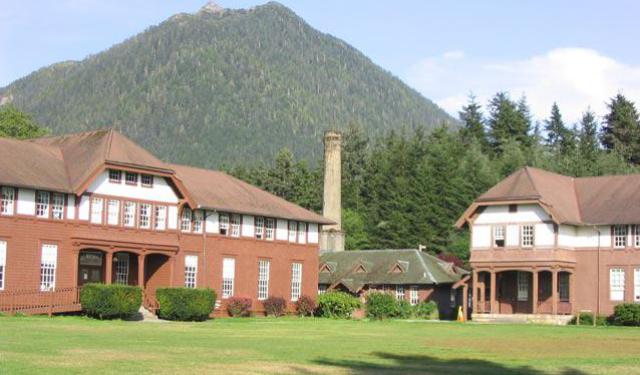Sitka Introduction Walking Tour (Self Guided), Sitka
Rubbing shoulders with the Tongass National Forest in Alaska, the coastal town of Sitka boasts a fascinating past, having served first as the capital of Russian America and then the Alaska Territory.
The name Sitka is derived from "Shee At'iká," which in the Tlingit language (of the indigenous people of Southeast Alaska and Western Canada) means"people on the outside of Shee," referring to Baranof Island, where the town is located.
Russian explorers settled Old Sitka in 1799, christening it as the Fort of Archangel Michael. Led by Alexander Baranov, governor of Russian America, under the Russian-American Company (a colonial trading entity chartered by Tsar Paul I), the settlement aimed at bolstering Russian presence in Alaska. However, in June 1802, Tlingit warriors decimated the original settlement, prompting Baranov to negotiate a hefty ransom for the survivors.
Returning in force in August 1804, Baranov led an assault on the Tlingit fortification. Despite initial setbacks, prolonged bombardment led to the surrender of the Tlingit, resulting in the establishment of New Archangel (or Novoarkhangelsk), which became the region's largest settlement and the capital of Russian America in 1808.
The presence of Bishop Innocent, a Russian Orthodox missionary, further solidified Sitka's significance. His residence, the Russian Bishop's House, later restored as part of Sitka National Historical Park, attests to the city's religious and educational importance. The construction of the Cathedral of Saint Michael in 1848 also symbolized the Russian Orthodox influence.
Sitka was the site of the transfer ceremony for the Alaska purchase on October 18, 1867. This transaction, driven by Russia's desire to offload the territory amid economic and political turmoil following the Crimean War, saw the United States acquiring Alaska for $7.2 million, at a mere 2 cents per acre.
Following the purchase, Sitka served as the capital of the US Government Department of Alaska until 1884 and the District of Alaska until 1906 when the government seat shifted to Juneau due to the latter's rising economic prominence during the Klondike Gold Rush.
In later years, Sitka gained military significance as the location of Alaska's first seaplane base established by the United States Navy in 1937, with the construction of Fort Ray commencing in 1941 for defense purposes during World War II.
From Alaska Natives to Russians, Sitka boasts a fascinating blend of cultures. You can take a self-guided stroll through the town and explore it on your own by stopping at notable points like the Sitka National Historical Park, the Baranof Castle State Historic Site, and the Sheldon Jackson Museum. So, go for it and make the most of your time in this part of America's North!
The name Sitka is derived from "Shee At'iká," which in the Tlingit language (of the indigenous people of Southeast Alaska and Western Canada) means"people on the outside of Shee," referring to Baranof Island, where the town is located.
Russian explorers settled Old Sitka in 1799, christening it as the Fort of Archangel Michael. Led by Alexander Baranov, governor of Russian America, under the Russian-American Company (a colonial trading entity chartered by Tsar Paul I), the settlement aimed at bolstering Russian presence in Alaska. However, in June 1802, Tlingit warriors decimated the original settlement, prompting Baranov to negotiate a hefty ransom for the survivors.
Returning in force in August 1804, Baranov led an assault on the Tlingit fortification. Despite initial setbacks, prolonged bombardment led to the surrender of the Tlingit, resulting in the establishment of New Archangel (or Novoarkhangelsk), which became the region's largest settlement and the capital of Russian America in 1808.
The presence of Bishop Innocent, a Russian Orthodox missionary, further solidified Sitka's significance. His residence, the Russian Bishop's House, later restored as part of Sitka National Historical Park, attests to the city's religious and educational importance. The construction of the Cathedral of Saint Michael in 1848 also symbolized the Russian Orthodox influence.
Sitka was the site of the transfer ceremony for the Alaska purchase on October 18, 1867. This transaction, driven by Russia's desire to offload the territory amid economic and political turmoil following the Crimean War, saw the United States acquiring Alaska for $7.2 million, at a mere 2 cents per acre.
Following the purchase, Sitka served as the capital of the US Government Department of Alaska until 1884 and the District of Alaska until 1906 when the government seat shifted to Juneau due to the latter's rising economic prominence during the Klondike Gold Rush.
In later years, Sitka gained military significance as the location of Alaska's first seaplane base established by the United States Navy in 1937, with the construction of Fort Ray commencing in 1941 for defense purposes during World War II.
From Alaska Natives to Russians, Sitka boasts a fascinating blend of cultures. You can take a self-guided stroll through the town and explore it on your own by stopping at notable points like the Sitka National Historical Park, the Baranof Castle State Historic Site, and the Sheldon Jackson Museum. So, go for it and make the most of your time in this part of America's North!
How it works: Download the app "GPSmyCity: Walks in 1K+ Cities" from Apple App Store or Google Play Store to your mobile phone or tablet. The app turns your mobile device into a personal tour guide and its built-in GPS navigation functions guide you from one tour stop to next. The app works offline, so no data plan is needed when traveling abroad.
Sitka Introduction Walking Tour Map
Guide Name: Sitka Introduction Walking Tour
Guide Location: USA » Sitka (See other walking tours in Sitka)
Guide Type: Self-guided Walking Tour (Sightseeing)
# of Attractions: 11
Tour Duration: 2 Hour(s)
Travel Distance: 2.0 Km or 1.2 Miles
Author: DanaOffice
Sight(s) Featured in This Guide:
Guide Location: USA » Sitka (See other walking tours in Sitka)
Guide Type: Self-guided Walking Tour (Sightseeing)
# of Attractions: 11
Tour Duration: 2 Hour(s)
Travel Distance: 2.0 Km or 1.2 Miles
Author: DanaOffice
Sight(s) Featured in This Guide:
- Totem Square
- Lincoln Street
- St. Michael's Cathedral
- Baranof Castle State Historic Site
- Sitka Historical Museum
- Crescent Harbor
- Russian Bishop's House
- St. Peter's by the Sea Episcopal Church
- Sheldon Jackson Museum
- Sound Science Center
- National Historical Park
1) Totem Square
Totem Square holds significant cultural and historical importance, serving as a focal point for the community and visitors alike. In November 2011, a momentous event took place at Totem Square when a revered totem pole, which had been removed for restoration, was ceremoniously returned to its rightful place. The restoration work was meticulously carried out by local totem pole expert Tommy Joseph at the Southeast Indian Cultural Center in the Sitka National Historic Park Visitor Center. Drawing upon the original design by George Benson, the restoration aimed to preserve the authenticity and integrity of the totem pole.
The square itself holds great significance, as it fronts essential landmarks such as the town hall, Pioneer’s Home, the channel, the Totem Square Hotel, and downtown Sitka. A 2007 study highlighted the importance of Totem Square as a key destination for tourists, emphasizing its role in reflecting the cultural heritage and identity of Sitka. Without the presence of the totem pole, Totem Square was deemed incomplete, lacking the essence of its namesake. With the restored pole once again gracing Totem Square, there has been a renewed sense of pride and connection among the citizens of Sitka.
The square itself holds great significance, as it fronts essential landmarks such as the town hall, Pioneer’s Home, the channel, the Totem Square Hotel, and downtown Sitka. A 2007 study highlighted the importance of Totem Square as a key destination for tourists, emphasizing its role in reflecting the cultural heritage and identity of Sitka. Without the presence of the totem pole, Totem Square was deemed incomplete, lacking the essence of its namesake. With the restored pole once again gracing Totem Square, there has been a renewed sense of pride and connection among the citizens of Sitka.
2) Lincoln Street
Situated in the heart of downtown Sitka, Lincoln Street serves as a bustling thoroughfare that encapsulates the essence of this charming Alaskan community. Lined with an array of shops, eateries, galleries, and historical landmarks, Lincoln Street offers visitors and locals alike a captivating glimpse into Sitka's past and present.
One of the notable features of Lincoln Street is its rich architectural heritage, with many buildings reflecting the city's diverse cultural influences, including Russian, Tlingit, and American. Strolling along Lincoln Street, one can admire the unique blend of architectural styles that characterize Sitka's downtown area, from quaint wooden structures to grand facades adorned with intricate detailing.
In addition to its architectural charm, Lincoln Street is also a vibrant hub of activity, offering an array of shopping and dining experiences. Visitors can explore quaint boutiques offering locally crafted goods, art galleries showcasing the work of Alaskan artists, and souvenir shops brimming with treasures to commemorate their time in Sitka. Meanwhile, food enthusiasts can indulge in a diverse culinary scene, with restaurants serving up fresh seafood, international cuisine, and hearty comfort food.
One of the notable features of Lincoln Street is its rich architectural heritage, with many buildings reflecting the city's diverse cultural influences, including Russian, Tlingit, and American. Strolling along Lincoln Street, one can admire the unique blend of architectural styles that characterize Sitka's downtown area, from quaint wooden structures to grand facades adorned with intricate detailing.
In addition to its architectural charm, Lincoln Street is also a vibrant hub of activity, offering an array of shopping and dining experiences. Visitors can explore quaint boutiques offering locally crafted goods, art galleries showcasing the work of Alaskan artists, and souvenir shops brimming with treasures to commemorate their time in Sitka. Meanwhile, food enthusiasts can indulge in a diverse culinary scene, with restaurants serving up fresh seafood, international cuisine, and hearty comfort food.
3) St. Michael's Cathedral (must see)
Saint Michael's Cathedral stands as a profound symbol of Sitka's rich history as a European settlement predating the American Revolution, situated on the opposite coast from the English colonies and the burgeoning United States. This cathedral serves as the most prominent landmark of Russian America, towering over Sitka's downtown area. Initially constructed in the 1840s, the cathedral underwent a meticulous reconstruction in 1976 following its tragic destruction by fire in 1966. The rebuilt cathedral stands as an exact replica of its predecessor, preserving its architectural integrity and historical significance.
Adorned with a striking copper green onion dome and spire, Saint Michael's Cathedral reflects the architectural styles reminiscent of Saint Petersburg during the era of Russian settlement in Alaska. Within its hallowed halls, treasured religious icons dating back centuries are displayed, including two revered paintings flanking the altar screen doors: "Christ Omnipotent" and "Our Lady of Sitka" (also known as Sitka Madonna), believed by many to possess healing properties.
Among the cathedral's notable artifacts is the pearl-studded miter worn by Bishop Innocent Veniaminov, later canonized as Saint Innocent of Alaska. Saint Innocent's legacy transcends religious boundaries, as he was celebrated for his contributions as a skilled craftsman, linguist, missionary, and historian who played a pivotal role in documenting and preserving Native cultures in Southeast Alaska and the Aleutian Islands.
Saint Michael's Cathedral stands as a testament to the enduring influence of the Orthodox faith in Alaska, serving as the spiritual heart of the Russian Orthodox Church in the region. Each Saturday night, worshippers gather for services that include appeals from around the world for intercession by the revered Sitka Madonna. Beyond its religious significance, the cathedral embodies the spirit of cultural preservation and tolerance, as exemplified by Saint Innocent's efforts to safeguard Alaska's Native languages and traditions.
Adorned with a striking copper green onion dome and spire, Saint Michael's Cathedral reflects the architectural styles reminiscent of Saint Petersburg during the era of Russian settlement in Alaska. Within its hallowed halls, treasured religious icons dating back centuries are displayed, including two revered paintings flanking the altar screen doors: "Christ Omnipotent" and "Our Lady of Sitka" (also known as Sitka Madonna), believed by many to possess healing properties.
Among the cathedral's notable artifacts is the pearl-studded miter worn by Bishop Innocent Veniaminov, later canonized as Saint Innocent of Alaska. Saint Innocent's legacy transcends religious boundaries, as he was celebrated for his contributions as a skilled craftsman, linguist, missionary, and historian who played a pivotal role in documenting and preserving Native cultures in Southeast Alaska and the Aleutian Islands.
Saint Michael's Cathedral stands as a testament to the enduring influence of the Orthodox faith in Alaska, serving as the spiritual heart of the Russian Orthodox Church in the region. Each Saturday night, worshippers gather for services that include appeals from around the world for intercession by the revered Sitka Madonna. Beyond its religious significance, the cathedral embodies the spirit of cultural preservation and tolerance, as exemplified by Saint Innocent's efforts to safeguard Alaska's Native languages and traditions.
4) Baranof Castle State Historic Site (must see)
The Baranof Castle State Historic Site, also known as Castle Hill, holds significant historical importance in the annals of Alaska's past. Originally, this site was occupied by the Tlingit Natives, who constructed a strategic fortification atop the hill. The Tlingits used this position to defend against incursions and maintain control over the region. However, the tranquility of their occupation was shattered in 1804 when Russian forces massacred the Tlingits and claimed the site for themselves.
From 1804 to 1867, Castle Hill served as a key Russian outpost in Alaska. It played a pivotal role in the region's history, witnessing various events that shaped the fate of Alaska. Notably, it was on the summit of Castle Hill that the formal transfer of Alaska from Russia to the United States occurred in 1867. This historic event marked the beginning of Alaska's American era and cemented Castle Hill's status as a symbol of transition and change.
Today, visitors to the Baranof Castle State Historic Site can explore the remnants of this storied past. Accessible walkways or more challenging staircases lead to the summit, where panoramic views of Sitka Sound await. Particularly breathtaking at sunset, the vista offers a glimpse into the natural beauty that surrounds Sitka. Additionally, visitors can marvel at the engineering feat of the 450-foot-long cable-stayed bridge spanning the channel, further enhancing the experience atop Castle Hill.
From 1804 to 1867, Castle Hill served as a key Russian outpost in Alaska. It played a pivotal role in the region's history, witnessing various events that shaped the fate of Alaska. Notably, it was on the summit of Castle Hill that the formal transfer of Alaska from Russia to the United States occurred in 1867. This historic event marked the beginning of Alaska's American era and cemented Castle Hill's status as a symbol of transition and change.
Today, visitors to the Baranof Castle State Historic Site can explore the remnants of this storied past. Accessible walkways or more challenging staircases lead to the summit, where panoramic views of Sitka Sound await. Particularly breathtaking at sunset, the vista offers a glimpse into the natural beauty that surrounds Sitka. Additionally, visitors can marvel at the engineering feat of the 450-foot-long cable-stayed bridge spanning the channel, further enhancing the experience atop Castle Hill.
5) Sitka Historical Museum
The Sitka Historical Museum offers visitors a captivating journey through the city's rich and diverse history. One of its main attractions is a large-scale model of Sitka from 1867, the year when the Russians transferred the territory to the United States. This intricate model provides a fascinating glimpse into the layout and architecture of Sitka during this pivotal period in its history. Visitors can explore the streets, buildings, and landmarks of the town as it appeared over a century ago.
In addition to the model, the museum features exhibits that delve into various aspects of Sitka's past. Visitors can learn about traditional Tlingit lifestyles through displays showcasing artifacts such as tightly woven cedar and spruce root baskets. These exhibits shed light on the indigenous culture and heritage of the Tlingit people, highlighting their enduring connection to the land and sea. The museum also offers insights into Sitka's role during World War II, including stories of town blackouts and the military buildup that occurred in the area.
One of the unique aspects of the Sitka Historical Museum is its comprehensive approach to Sitka's history, encompassing the Tlingit, Russian, and American influences that have shaped the city over time. Highlights of the museum include a display on the Sheldon Jackson Campus, which traces the history of the school from its origins as a missionary school to its evolution into a college. Additionally, visitors can marvel at a Chilkat Blanket, a Tlingit robe woven from mountain goat fur and used by the "Killer Whale Clan" during ceremonies.
In addition to the model, the museum features exhibits that delve into various aspects of Sitka's past. Visitors can learn about traditional Tlingit lifestyles through displays showcasing artifacts such as tightly woven cedar and spruce root baskets. These exhibits shed light on the indigenous culture and heritage of the Tlingit people, highlighting their enduring connection to the land and sea. The museum also offers insights into Sitka's role during World War II, including stories of town blackouts and the military buildup that occurred in the area.
One of the unique aspects of the Sitka Historical Museum is its comprehensive approach to Sitka's history, encompassing the Tlingit, Russian, and American influences that have shaped the city over time. Highlights of the museum include a display on the Sheldon Jackson Campus, which traces the history of the school from its origins as a missionary school to its evolution into a college. Additionally, visitors can marvel at a Chilkat Blanket, a Tlingit robe woven from mountain goat fur and used by the "Killer Whale Clan" during ceremonies.
6) Crescent Harbor
Crescent Harbor, one of the five boat harbors operated and maintained by the City and Borough of Sitka Harbor Department in Sitka, offers a comprehensive array of services and facilities for both commercial and recreational vessels. Situated conveniently within walking distance of grocery stores, marine supply outlets, restaurants, and downtown Sitka, Crescent Harbor provides easy access to amenities for boaters and visitors alike. The harbor department ensures that all harbors, including Crescent Harbor, are equipped with restrooms, shower facilities located above Eliason Harbor, and essential infrastructure to meet the needs of the boating community.
Notably, Crescent Harbor accommodates a diverse fleet of vessels, ranging from commercial fishing boats to recreational and charter vessels. During the summer months, the harbor welcomes large yachts from around the world, further enhancing its status as a vibrant maritime hub. Additionally, Sitka's designation as the fourth Alaska Clean Harbor in 2016 underscores its commitment to environmental stewardship. By implementing best management practices to prevent pollution and reduce waste, Crescent Harbor and other certified Alaska Clean Harbors contribute to preserving water quality and enhancing the overall harbor experience for residents and visitors.
With its strategic location, comprehensive facilities, and dedication to environmental sustainability, Crescent Harbor remains an essential maritime asset in Sitka, serving as a gateway to the stunning natural beauty and abundant marine resources of Alaska's Inside Passage.
Notably, Crescent Harbor accommodates a diverse fleet of vessels, ranging from commercial fishing boats to recreational and charter vessels. During the summer months, the harbor welcomes large yachts from around the world, further enhancing its status as a vibrant maritime hub. Additionally, Sitka's designation as the fourth Alaska Clean Harbor in 2016 underscores its commitment to environmental stewardship. By implementing best management practices to prevent pollution and reduce waste, Crescent Harbor and other certified Alaska Clean Harbors contribute to preserving water quality and enhancing the overall harbor experience for residents and visitors.
With its strategic location, comprehensive facilities, and dedication to environmental sustainability, Crescent Harbor remains an essential maritime asset in Sitka, serving as a gateway to the stunning natural beauty and abundant marine resources of Alaska's Inside Passage.
7) Russian Bishop's House (must see)
The Russian Bishop's House stands as a remarkable testament to the Russian colonial legacy in North America,. Constructed in 1842, this historic structure is one of the few remaining examples of Russian colonial architecture on the continent. Sitka, known as New Archangel during the Russian colonial era, served as the capital of Russian America, and the Bishop's House played a central role in the region's religious and administrative affairs.
During its heyday, the Bishop's House served as the hub of Russian Orthodox Church authority in a vast diocese that extended from California to Siberian Kamchatka. As a symbol of the Russian Orthodox Church's influence and presence in the region, the Bishop's House held significant religious and cultural importance for the local community. However, by the late 20th century, the once-proud structure had fallen into disrepair, with deteriorating walls, leaking roofs, and structural instability threatening its survival.
In 1973, for over 16 years, meticulous efforts were undertaken to restore the building to its original 1853 appearance, ensuring that future generations could experience and appreciate the rich history and heritage of Sitka's Russian-American period. Today, visitors to the restored Russian Bishop's House have the opportunity to step back in time and gain insight into daily life during the Russian colonial era, offering a glimpse into Sitka's fascinating past and cultural heritage.
During its heyday, the Bishop's House served as the hub of Russian Orthodox Church authority in a vast diocese that extended from California to Siberian Kamchatka. As a symbol of the Russian Orthodox Church's influence and presence in the region, the Bishop's House held significant religious and cultural importance for the local community. However, by the late 20th century, the once-proud structure had fallen into disrepair, with deteriorating walls, leaking roofs, and structural instability threatening its survival.
In 1973, for over 16 years, meticulous efforts were undertaken to restore the building to its original 1853 appearance, ensuring that future generations could experience and appreciate the rich history and heritage of Sitka's Russian-American period. Today, visitors to the restored Russian Bishop's House have the opportunity to step back in time and gain insight into daily life during the Russian colonial era, offering a glimpse into Sitka's fascinating past and cultural heritage.
8) St. Peter's by the Sea Episcopal Church
Saint Peter's by-the-Sea Episcopal Church stands as a testament to the enduring beauty of Gothic Revival architecture. Commonly referred to as Saint Peter's Episcopal Church, this historic building exudes a sense of timeless charm and spiritual significance. Constructed in 1899, it represents the first substantial Episcopal church in Sitka, a town where religious services were previously held in smaller venues.
The architecture of Saint Peter's by-the-Sea is characterized by its Gothic Revival style, featuring a harmonious blend of stone and wood elements. The church boasts a modest bell tower crowned with a pyramidal roof, adding a touch of elegance to its exterior. Noteworthy architectural details include stone buttresses that line the sides of the building, enhancing its structural integrity and visual appeal. The rose window, adorned with a Star of David, adds a symbolic touch to the façade, reflecting the church's commitment to inclusivity and spiritual diversity.
Listed on the National Register of Historic Places in 1978, Saint Peter's by-the-Sea Episcopal Church holds significant cultural and architectural significance. Beyond its physical attributes, the church serves as a sacred space where worshippers gather to seek solace, community, and spiritual nourishment.
The architecture of Saint Peter's by-the-Sea is characterized by its Gothic Revival style, featuring a harmonious blend of stone and wood elements. The church boasts a modest bell tower crowned with a pyramidal roof, adding a touch of elegance to its exterior. Noteworthy architectural details include stone buttresses that line the sides of the building, enhancing its structural integrity and visual appeal. The rose window, adorned with a Star of David, adds a symbolic touch to the façade, reflecting the church's commitment to inclusivity and spiritual diversity.
Listed on the National Register of Historic Places in 1978, Saint Peter's by-the-Sea Episcopal Church holds significant cultural and architectural significance. Beyond its physical attributes, the church serves as a sacred space where worshippers gather to seek solace, community, and spiritual nourishment.
9) Sheldon Jackson Museum (must see)
The Sheldon Jackson Museum stands as a testament to the pioneering spirit of its founder, Dr. Sheldon Jackson, a prominent figure in late 19th-century Alaska. Dr. Jackson's remarkable legacy encompasses a diverse range of endeavors, including the establishment of Protestant missions and schools, the introduction of reindeer to Alaska, and the development of the public school system. Throughout his travels across Alaska and the coast of Siberia, Dr. Jackson collected a vast array of artifacts, many of which now form the core of the museum's extensive collection.
Established in 1888 on the campus of Sheldon Jackson College, the museum was envisioned as a repository for preserving the natural and cultural history of Alaska. Housed in a historic building constructed in 1895, which holds the distinction of being the oldest concrete building in the state, the museum exudes an aura of historical significance. Listed on the National Register of Historic Sites, the museum transitioned to become one of the Alaska State Museums in 1984, further solidifying its role in safeguarding Alaska's heritage.
The museum's collection is a treasure trove of artifacts representing various indigenous cultures of Alaska, including the Inupiat, Yup'ik, Unangax, Athabascan, and Northwest Coast peoples. Visitors are treated to a diverse array of exhibits showcasing masks, carvings, tools, and boats that offer insights into the rich cultural tapestry of Alaska's native inhabitants. Highlights include an Unangan baidarka (skin kayak) and a Tlingit dugout canoe, which provide fascinating glimpses into traditional modes of transportation and craftsmanship.
Additionally, the museum features interactive displays, such as drawers containing artifacts organized by category, allowing visitors to compare tools, toys, and hunting implements across different cultures and trace the influence of European materials on native crafts. Through its engaging exhibits, films, and thematic arrangements in collaboration with local wildlife festivals, such as Sitka's WhaleFest, the Sheldon Jackson Museum offers visitors a captivating journey through Alaska's cultural heritage.
Established in 1888 on the campus of Sheldon Jackson College, the museum was envisioned as a repository for preserving the natural and cultural history of Alaska. Housed in a historic building constructed in 1895, which holds the distinction of being the oldest concrete building in the state, the museum exudes an aura of historical significance. Listed on the National Register of Historic Sites, the museum transitioned to become one of the Alaska State Museums in 1984, further solidifying its role in safeguarding Alaska's heritage.
The museum's collection is a treasure trove of artifacts representing various indigenous cultures of Alaska, including the Inupiat, Yup'ik, Unangax, Athabascan, and Northwest Coast peoples. Visitors are treated to a diverse array of exhibits showcasing masks, carvings, tools, and boats that offer insights into the rich cultural tapestry of Alaska's native inhabitants. Highlights include an Unangan baidarka (skin kayak) and a Tlingit dugout canoe, which provide fascinating glimpses into traditional modes of transportation and craftsmanship.
Additionally, the museum features interactive displays, such as drawers containing artifacts organized by category, allowing visitors to compare tools, toys, and hunting implements across different cultures and trace the influence of European materials on native crafts. Through its engaging exhibits, films, and thematic arrangements in collaboration with local wildlife festivals, such as Sitka's WhaleFest, the Sheldon Jackson Museum offers visitors a captivating journey through Alaska's cultural heritage.
10) Sound Science Center
The Sitka Sound Science Center offers a captivating exploration of Southeast Alaska's unique marine ecosystem through its aquarium and hatchery facilities. Visitors are invited to immerse themselves in the wonders of the underwater world, experiencing firsthand the diverse marine life that inhabits the waters of Sitka Sound. One of the highlights of the center is the tidal-pool touch tanks, where guests can interact with spiky sea urchins, bumpy sea stars, and other fascinating creatures found along the intertidal zone.
Step into the Salmon Bubble exhibit and gain a fish-eye view of the ocean as you observe the underwater world from a salmon's perspective. Delve deeper into the mysteries of the ocean by gazing into the 60 Feet Deep tank, which is home to a variety of marine species including rockfish, eels, and other creatures that thrive in the depths of Alaska's waters. The aquarium also features Wanda the Wolf Eel, along with other deep-water and intertidal residents collected from Sitka's local waters.
Through guided tours and interactive experiences, guests can gain insights into the center's research initiatives and the processes involved in maintaining a public aquarium. The Behind-the-Scenes tour offers a glimpse into areas not typically accessible to the public, while Aquarium 101 and Hatchery 101 provide hands-on learning experiences focused on animal care, tank maintenance, and the lifecycle of salmon from egg to ocean.
Step into the Salmon Bubble exhibit and gain a fish-eye view of the ocean as you observe the underwater world from a salmon's perspective. Delve deeper into the mysteries of the ocean by gazing into the 60 Feet Deep tank, which is home to a variety of marine species including rockfish, eels, and other creatures that thrive in the depths of Alaska's waters. The aquarium also features Wanda the Wolf Eel, along with other deep-water and intertidal residents collected from Sitka's local waters.
Through guided tours and interactive experiences, guests can gain insights into the center's research initiatives and the processes involved in maintaining a public aquarium. The Behind-the-Scenes tour offers a glimpse into areas not typically accessible to the public, while Aquarium 101 and Hatchery 101 provide hands-on learning experiences focused on animal care, tank maintenance, and the lifecycle of salmon from egg to ocean.
11) National Historical Park
Sitka National Historical Park, although Alaska's smallest national historical park in terms of size, looms large in both Alaska's history and its stunning natural beauty. Established in 1890, it holds the distinction of being the oldest federally designated park in the state. Nestled within a lush rainforest of towering Sitka spruce trees, the 113-acre park is conveniently located within easy walking distance of downtown Sitka. Its significance lies in its rich tapestry of Tlingit and Russian history, as well as its cultural and scenic attractions.
At the heart of the park are authentic Tlingit and Haida totem poles, which stand as enduring symbols of indigenous artistry and heritage. These magnificent totems are set against the backdrop of the verdant forest, creating a mesmerizing tableau that speaks to the cultural legacy of the region. The Sitka National Historical Park Visitor Center serves as a gateway to the park's history, displaying a captivating array of Russian and Tlingit artifacts. Visitors can delve deeper into the area's past through educational exhibits and a theater presentation that illuminates the park's rich cultural heritage.
During the summer months, the park comes alive with the Demonstrating Artists Program, offering visitors a unique opportunity to witness Alaska Native artists at work. Within the visitor center, three art studios provide a glimpse into traditional woodworking, beading, weaving, and metal engraving techniques.
As visitors venture along the Totem Trail, a scenic mile-long path meandering through the ancient forest, they encounter 18 intricately carved Tlingit and Haida totems, each telling its own story. The trail culminates at the Russian Memorial Trail, leading to the historic grounds of the Battle of Sitka, a pivotal event that shaped the region's history.
At the heart of the park are authentic Tlingit and Haida totem poles, which stand as enduring symbols of indigenous artistry and heritage. These magnificent totems are set against the backdrop of the verdant forest, creating a mesmerizing tableau that speaks to the cultural legacy of the region. The Sitka National Historical Park Visitor Center serves as a gateway to the park's history, displaying a captivating array of Russian and Tlingit artifacts. Visitors can delve deeper into the area's past through educational exhibits and a theater presentation that illuminates the park's rich cultural heritage.
During the summer months, the park comes alive with the Demonstrating Artists Program, offering visitors a unique opportunity to witness Alaska Native artists at work. Within the visitor center, three art studios provide a glimpse into traditional woodworking, beading, weaving, and metal engraving techniques.
As visitors venture along the Totem Trail, a scenic mile-long path meandering through the ancient forest, they encounter 18 intricately carved Tlingit and Haida totems, each telling its own story. The trail culminates at the Russian Memorial Trail, leading to the historic grounds of the Battle of Sitka, a pivotal event that shaped the region's history.
Walking Tours in Sitka, Alaska
Create Your Own Walk in Sitka
Creating your own self-guided walk in Sitka is easy and fun. Choose the city attractions that you want to see and a walk route map will be created just for you. You can even set your hotel as the start point of the walk.
Historical Buildings Walk
The historical landmarks of Sitka serve as windows to pivotal moments in Alaska's past. From battlegrounds and fortresses to churches, schools, and military bases, these locations offer a fascinating peek into Sitka's varied and influential history, highlighting its significant contributions to both Alaskan and American narratives.
Among these sites is Sheldon Jackson College.... view more
Tour Duration: 2 Hour(s)
Travel Distance: 2.3 Km or 1.4 Miles
Among these sites is Sheldon Jackson College.... view more
Tour Duration: 2 Hour(s)
Travel Distance: 2.3 Km or 1.4 Miles
The Most Popular Cities
/ view all
